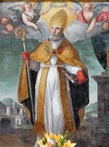


According to the Dialogues of Pope Gregory I, St Fulgentus was Bishop of Otricoli when Totila threatened the city (ca. 543). Totila had him arrested and confined within a circle marked out on the ground in the baking heat of a summer's day. A miraculous storm cooled the bishop but left him dry while the Goths were drenched, causing Totila to relent and saving the city from destruction.

The only other record from the lifetime of St Fulgentius comes from an inscription (late 6th century) from San Vittore, Ocriculum records that St Fulgentius discovered the relics of St Victor in the church and erected an altar over his grave. This inscription, which is in two lines flanking a relief of o cross and two lambs, reads:
IVBANTE DEO FVLGENTIVS EPISCOPVS INVENTO CORPORE
MARTYRIS VICTORIS IN XR(IST)I NOMINE SVPER ALTARE CONSTRVXIT
According to Gianfranco Binazzi (referenced below, at p. 6):
-
“The dedicatory inscription is sculpted on the altar (of which only the edge survives) erected by bishop Fulgentius above the tomb of the martyr Victor, which he had discovered in the middle of the 6th century” (my translation).
Ludovico Jacobili (referenced below, at p. 762) recorded that:
-
“This inscription and image can be seen at the foot of the first step of the high altar at [Santa Maria Assunta], having been taken there in 1351 on the occasion of the translation to this church of the relics of St Victor” (my translation).
The inscription is now set into the wall of the presbytery, to the left of the high altar.
Death of St Fulgentius
Neither the date nor the circumstances of St Fulgentius’ death are known, but he must have died before 595, when bishop Domenico of Otricoli was documented.

A second inscription in Santa Maria Assunta (on the left wall of the presbytery, above the door to the sacristy) reveals that he was considered to have been a martyr:
Hic requiescunt S(an)cti Fulgentius
Lozimus Nectarius Leopardus et Corona
martyres C(h)r(ist)i
This text is inscribed in a single line on what was probably an architrave. Gianfranco Binazzi (referenced below, at p. 7) observed that:
-
“As far as chronology is concerned, both the characters and the formula [used in the inscription] point to a date after the 6th century, but it is otherwise difficult to establish it with precision” (my translation).
Its original location is discussed below.
Ludovico Jacobili (referenced below, at p. 764) believed that St Fulgentius had died during his torture by Totila’s soldiers, although Gregory I (above) had made no such claim. He dated the death to the 3rd December ca. 546. Totila was then summoned by his soldiers and found St Fulgentius not only dead but still in the act of oration. He was so impressed that he and his followers reverently carried the body for burial at San Vittore (see the page on Ocriculum).
Translations of the Relics (1316 and 1672)
Ludovico Jacobili (referenced below, at p. 500) recorded that:
-
“In 1316, Bishop Peter of Narni translated from San Vittore .... to [Santa Maria Assunta] the remains of the martyrs SS Fulgentius, Lozimus Nectarius Leopardus and Corona and placed them under the altar dedicated to St Fulgentius [now the Cappella di Sant’ Antonio Abate, to the left of the presbytery]. ” (my translation).
He gave the precise date at p. 764: 7th May 1316. He also recorded two inscriptions that were placed nearby at this time, one of which was in marble and was almost certainly the inscription transcribed above. It seems likely that this inscription originally belonged to the portal of the room (presumably a crypt) at San Vittore that had housed the relics, and that it had been moved with the relics to Santa Maria Assunta in 1316.

Read more:
E. D’Angelo, “Otricoli e i Suoi Santi: Storia, Liturgia, Epigrafia, Agiografia”, (2012) Spoleto (pp. 33-41)
G. Binazzi, “Inscriptiones Christianae Italiae: Regio VI; Umbria”, (1989) Bari
L. Jacobili “Vite de’ Santi e Beati dell’ Umbria”, (1647-61, republished in 2008) Sala Bolognese:
-the material on SS Victor and Corona is in Volume I, pp. 494 - 501; and
-the material on St Fulgenius is in Volume I, pp. 760-5
For the historical background, see the page on the history of Otricoli.
Return to the page on Saints of Otricoli.

